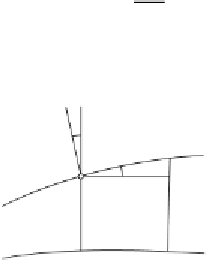Geoscience Reference
In-Depth Information
A historical remark
This remark is due to Mrs. M. I. Yurkina, Moscow. Mathematically, the
above is the solution of Neumann's problem (the second boundary-value
problem of potential theory) for the sphere, cf. Sect. 1.13. It is a classical
problem of potential theory, with a history of at least 150 years, similarly
to Stokes' formula. “Neumann's problem” is named after the mathematician
Carl Neumann, who edited his father's (Franz Neumann) lectures from the
1850s (Neumann 1887: see especially p. 275). The external spherical Neu-
mann problem also occurs in Kellogg (1929: p. 247). It is again found in
Hotine (1969: pp. 311, 318).
Their basic significance for modern physical geodesy with a known earth
surface was recognized and elaborated by Koch (1971). So the present inte-
gral formula should perhaps be called F. Neumann - C. Neumann - Kellogg -
Hotine - Koch formula. For brevity, we refer to it as
Koch's formula
.
2.19
Deflections of the vertical and formula of
Vening Meinesz
Stokes' formula permits the calculation of the geoidal undulations from grav-
ity anomalies. A similar formula for the computation of the deflections of the
vertical from gravity anomalies has been given by Vening Meinesz (1928).
Figure 2.18 shows the intersection of geoid and reference ellipsoid with
a vertical plane of arbitrary azimuth. If
ε
is the component of the deflection
of the vertical in this plane, then
dN
=
−εds
(2-372)
or
dN
ds
ε
=
−
;
(2-373)
the minus sign is a convention, its meaning will be explained later.
plumb line
ellipsoidal normal
"
geoid
"
dN
ds
ds
ellipsoid
s
Fig. 2.18. The relation between the geoidal undulation and the
deflection of the vertical


